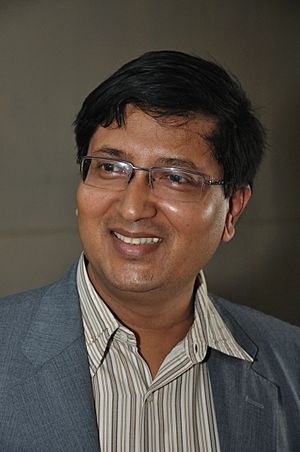Sandip Chakrabarti facts for kids
Quick facts for kids
Sandip Chakrabarti
|
|
|---|---|

Sandip Chakrabarti
|
|
| Born | 15 November 1958 Malda, West Bengal, India
|
| Nationality | Indian |
| Citizenship | Indian |
| Alma mater | University of Chicago (Ph.D) IIT Kanpur (M.Sc) Ramakrishna Mission Residential College, Narendrapur (B.Sc) |
| Known for | Research in Black Hole Astrophysics, low cost balloon borne science, Astrochemistry leading to biomolecules, ionospheric science and earthquake predictions. |
| Awards | Received DSc from University of Gour Banga, Received Banga Ratna from Government of West Bengal. |
| Scientific career | |
| Fields | Astrophysics |
| Institutions | Director and Distinguished Professor at Indian Centre for Space Physics, Kolkata |
| Doctoral advisor | W. David Arnett, University of Chicago |
Sandip Chakrabarti is an Indian astrophysicist. An astrophysicist is a scientist who studies space and the objects in it, like stars, planets, and black holes. Dr. Chakrabarti is known for his research on black holes. He also created a computer model to explore how life on Earth might have started in outer space.
Contents
His Early Life and Education
Sandip Chakrabarti was born in Malda, West Bengal, India. He went to Lalit Mohan Shyam Mohini High School there. After high school, he studied Physics at Ramakrishna Mission Residential College. He earned his Bachelor of Science degree in 1979.
University Studies and Research
He then went to IIT Kanpur and completed his Master of Science degree in Physics in 1981. Later that year, he joined the Physics Department at the University of Chicago. There, he worked on important topics like "Time like Curves of limited acceleration in General Relativity." He also studied how massive particles behave near black holes.
Dr. Chakrabarti focused on the study of black holes for his PhD. He earned his PhD in 1985. After that, he became a R.C. Tolman Fellow at Caltech. During this time, he researched how matter moves around black holes. He also studied how elements are formed near black holes.
His Career in Space Physics
After working at ICTP, Trieste, Dr. Chakrabarti joined the Tata Institute of Fundamental Research. He also worked at the S.N. Bose National Centre. From 1994 to 1995, he was a Senior Associate at NASA Goddard Space Flight Centre.
Founding a Space Research Center
In 1999, Dr. Chakrabarti founded the Indian Centre for Space Physics in Kolkata. He is currently the Director and a Distinguished Professor there. This center focuses on research related to space and the universe.
What Does Dr. Chakrabarti Research?
Dr. Chakrabarti's main research focuses on how matter behaves around black holes. He studies how gas and dust fall into black holes. He showed that this matter must move at very high speeds. It also creates shock waves as it falls in.
Understanding Black Hole Behavior
He and his team have studied many aspects of these flows. They showed that matter falling into black holes does not always follow simple paths. This complex movement affects what we observe from black holes. Dr. Chakrabarti wrote the first major book on this topic in 1990. It is called "Theory of Transonic Astrophysical Flows."
He has written over 650 research papers. He has also written or edited several books. Forty-eight students have completed their PhDs under his guidance.
Discoveries About Black Holes and Gamma-ray Bursts
In 1995, Dr. Chakrabarti was the first scientist to suggest something important. He proposed that Gamma-ray bursts are like the "birth cry" of black holes. Gamma-ray bursts are very powerful explosions in space. In 2013, scientists found strong evidence that he was right.
He also suggested in the 1990s that matter orbiting black holes could change gravitational wave signals. Gravitational waves are ripples in space-time. These ideas help us understand more about the universe.

